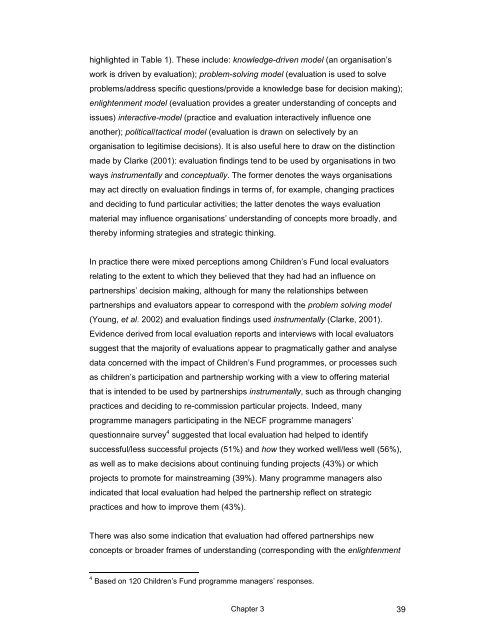Local Evaluation of Children's Services Learning from the Children's ...
Local Evaluation of Children's Services Learning from the Children's ...
Local Evaluation of Children's Services Learning from the Children's ...
- No tags were found...
Create successful ePaper yourself
Turn your PDF publications into a flip-book with our unique Google optimized e-Paper software.
highlighted in Table 1). These include: knowledge-driven model (an organisation’swork is driven by evaluation); problem-solving model (evaluation is used to solveproblems/address specific questions/provide a knowledge base for decision making);enlightenment model (evaluation provides a greater understanding <strong>of</strong> concepts andissues) interactive-model (practice and evaluation interactively influence oneano<strong>the</strong>r); political/tactical model (evaluation is drawn on selectively by anorganisation to legitimise decisions). It is also useful here to draw on <strong>the</strong> distinctionmade by Clarke (2001): evaluation findings tend to be used by organisations in twoways instrumentally and conceptually. The former denotes <strong>the</strong> ways organisationsmay act directly on evaluation findings in terms <strong>of</strong>, for example, changing practicesand deciding to fund particular activities; <strong>the</strong> latter denotes <strong>the</strong> ways evaluationmaterial may influence organisations’ understanding <strong>of</strong> concepts more broadly, and<strong>the</strong>reby informing strategies and strategic thinking.In practice <strong>the</strong>re were mixed perceptions among Children’s Fund local evaluatorsrelating to <strong>the</strong> extent to which <strong>the</strong>y believed that <strong>the</strong>y had had an influence onpartnerships’ decision making, although for many <strong>the</strong> relationships betweenpartnerships and evaluators appear to correspond with <strong>the</strong> problem solving model(Young, et al. 2002) and evaluation findings used instrumentally (Clarke, 2001).Evidence derived <strong>from</strong> local evaluation reports and interviews with local evaluatorssuggest that <strong>the</strong> majority <strong>of</strong> evaluations appear to pragmatically ga<strong>the</strong>r and analysedata concerned with <strong>the</strong> impact <strong>of</strong> Children’s Fund programmes, or processes suchas children’s participation and partnership working with a view to <strong>of</strong>fering materialthat is intended to be used by partnerships instrumentally, such as through changingpractices and deciding to re-commission particular projects. Indeed, manyprogramme managers participating in <strong>the</strong> NECF programme managers’questionnaire survey 4 suggested that local evaluation had helped to identifysuccessful/less successful projects (51%) and how <strong>the</strong>y worked well/less well (56%),as well as to make decisions about continuing funding projects (43%) or whichprojects to promote for mainstreaming (39%). Many programme managers alsoindicated that local evaluation had helped <strong>the</strong> partnership reflect on strategicpractices and how to improve <strong>the</strong>m (43%).There was also some indication that evaluation had <strong>of</strong>fered partnerships newconcepts or broader frames <strong>of</strong> understanding (corresponding with <strong>the</strong> enlightenment4 Based on 120 Children’s Fund programme managers’ responses.Chapter 3 39
















